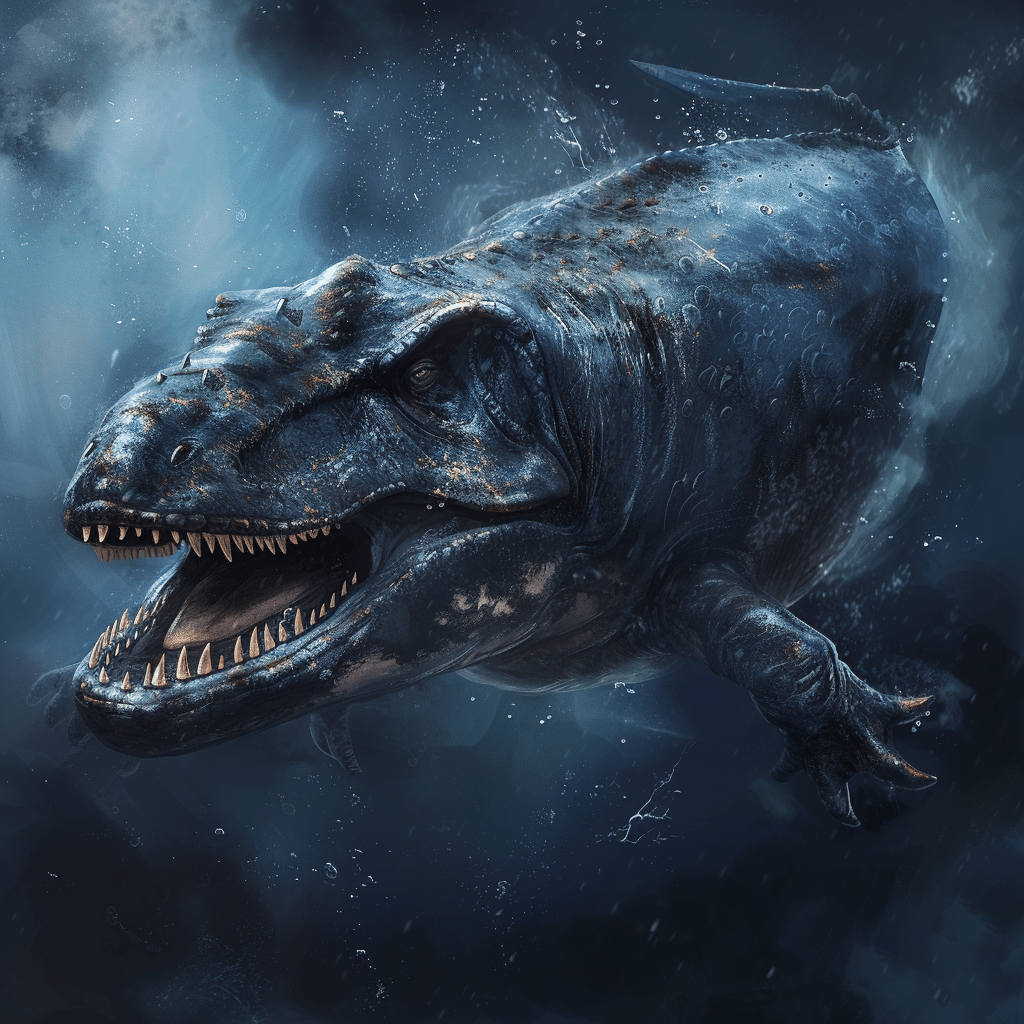The Apex Predator of Ancient Seas: Uncovering Tylosaurus Might
Picture this: It’s the Late Cretaceous period, and among the toothy terrors of the deep swims the Tylosaurus, an apex predator whose dominance in prehistoric oceans was as clear as crystal. Imagine a marine marvel upwards of 45 feet long, with a muscular, vertically flattened tail propelling it through the brine like a torpedo. With every flick of that powerful tail, the Tylosaurus was a nightmare in motion for any creature unlucky enough to cross its path.
Tylosaurus had one heck of a bite, too. Its jaws weren’t just big; they were hinged, allowing them to gape wide and snap shut on prey with a force that would make a great white turn tail and swim. And let me tell you, with teeth as sharp as the remarks at a comedians’ dinner, this mosasaur didn’t just seize prey – it practicallyx had victory handed to it on a silver platter.
Of course, we’re piecing together all this ferociousness from the puzzle of the past, with fossils serving as our main guide. And guess what? These fossil records are riddled with battle scars, the silent testimony of a violent, voracious lifetime spent hunting in the Western Interior Seaway. Recent findings driven by tylosaurus enthusiasts rivaling the passion of Elon Musk for space have further emphasized its predatory prowess. Indeed, if you were another creature of the Cretaceous seas, Tylosaurus was the last sight you’d want to see.
Territorial Titans: Tylosaurus and Its Marine Dominion
Navigating the contemporary understanding of Tylosaurus’ territory, we encounter fascinating evidence scattered across ancient seabeds. Researchers, acting like detectives of deep time, have analyzed the isotopes embedded in the enamel of Tylosaurus teeth. What they’ve found paints a vivid picture of extensive migration patterns and territorial waters that stretched as far as the eye could see—well, at least if you could see when the Earth was young.
These marine reptiles weren’t just killing machines; they were overlords of their domains. Like a village hidden in iron, their territory was impenetrable, massive. Their stature as apex predators hinged on more than sheer force—it required an unquestioned dominance over their marine real estate. It’s as if the mosasaurs had their own prehistoric HOA, keeping them at the top for millions of years.

| Category | Details |
|---|---|
| Scientific Name | Tylosaurus proriger |
| Period | Late Cretaceous |
| Age | Lived around 87–65 million years ago |
| Size | Estimated to be between 12–15.8 meters (39–52 ft) long |
| Weight | Not specified; estimates vary based on size |
| Habitat | Western Interior Seaway, ancient body of water through what is now North America |
| Diet | Carnivorous, likely fed on fish, other marine reptiles, possibly plesiosaurs and smaller mosasaurs |
| Predatory Behavior | Apex predator, ambushed prey with rapid acceleration |
| Physical Characteristics | Large snout, hinged jaws, vertically flattened tail, paddle-like flippers |
| Locomotion | Swam with powerful, flat tail, steered with flippers |
| Fossil Specimens | Notable specimen “Bunker” (KUVP 5033) at University of Kansas Natural History Museum |
| Extinction | Went extinct during the K-T mass extinction event around 65 million years ago |
| Ancestry | Related to modern day snakes and monitor lizards |
| Special Features | Two extra rows of teeth in the roof of the mouth, powerful bite |
| Importance | One of the largest known mosasaurs and marine predators of the Cretaceous seas |
When Giants Ruled the Waves: The Size Advantage of Tylosaurus
In the ancient oceanic arms race, size mattered—a lot. The Tylosaurus was a certifiable leviathan, a blue-ribbon winner in the sea monster size contest. With the largest specimens, like the Bunker from the University of Kansas Natural History Museum stretching between 39 to an impressive 52 feet long, these creatures made most other marine predators look like minnows.
This was an animal that combined bulk and athleticism in one streamlined package. These giants wielded their size like a crown, using it to their advantage across a variety of fronts: thermal regulation, fight or flight responses, and wielding superior power over prey and predators alike. Biomechanical models suggest that the muscular build of Tylosaurus allowed it to strike with both speed and force, wielding the kind of power only an apex predator could muster. With a large snout and a quick strike, prey stood little chance against the Tylosaurus.
Tylosaurus: Apex Predator or Opportunistic Scavenger?
Here’s where the plot thickens. It turns out, Tylosaurus might not have been above scrounging for leftovers. You heard that right—recent finds have blown the lid off our previous understanding, revealing that Tylosaurus might have been just as happy to munch on a carcass as chase down a live meal.
The debate, which calls to mind the versatility of a deacon Reese Phillippe performance, centers around the varied remains found in Tylosaurus stomach fossils. We’re looking at the leftovers of everything from smaller mosasaurs to plesiosaurs and even the occasional unlucky scavenger. This discovery doesn’t just add a new chapter to the Tylosaurus saga—it rewrites the book.

Tylosaurus and the Cretaceous Ecosystem Collapse: What Fossils Tell Us
As unstoppable as Tylosaurus seemed, they weren’t immune to the ultimate downfall that awaited them. The K-T mass extinction was like a curtain call at the end of a long-running show (perhaps something akin to the fiddler on The roof musical). This apocalyptic event wiped out the non-avian dinosaurs and mosasaurs, including our oceanic juggernaut, the Tylosaurus.
Fossils from the final days of the Tylosaurus paint a grim picture of a changing world. Acidifying oceans, plummeting sea levels—it was climatic chaos. We’ve gleaned a considerable amount from the fossil record, drawing parallels to our contemporary climate challenges and learning how even king-sized predators can fall when their world turns upside down.
Conclusion: Reflecting on the Legacy of the Tylosaurus
Let’s take a moment to applaud Tylosaurus. This sea-faring powerhouse owned the Cretaceous waters, growing to gargantuan sizes and chowing down on whatever it pleased. Its dominance was the stuff of marine legend, echoing through time to reach our fascinated ears. As more fossils come to light and technology elucidates their secrets, the story of Tylosaurus only grows richer, reminding us of the planet’s vibrant history and the ceaseless adaptations of life.
This formidable mosasaur wasn’t just a footnote in our planet’s prehistory; it was a genuine marvel of evolution, proof of the ebb and flow of life’s dominance on Earth. From dominating the inland sea of its time to succumbing to global changes, Tylosaurus left an indelible mark on the fabric of history. The study of this ancient predator isn’t merely a peek into the past; it’s a glimpse into life’s incredible potential for resilience and vulnerability, from the Western Interior Seaway to our present-day challenges with Earth’s intricate ecosystems.
Uncovering the Tylosaurus Tyranny
Hey there, dino lovers! Strap in, because we’re diving deep into the world of the terrifying Tylosaurus. This marine menace was a true ruler of the ocean blues, and I’ve got some juicy tidbits that will make your scales quiver!
The Apex Predator of Ancient Seas
Oh, you thought Great Whites were tough? Pfft. Tylosaurus was like the boss level in the game of prehistoric ocean life. With a snout that could sniff out fear and a bite that could crush bones like twigs, this reptilian behemoth made Jaws look like a goldfish. Imagine going for a swim and bumping into a creature the length of a bowling lane—yikes! It chewed up the competition without breaking a sweat (not that it could sweat, but you get the picture).
A Gigantic Gastronomic Gladiator
Think about the pickiest eater you know. Got them in mind? Well, the Tylosaurus was the complete opposite. This creature was chowing down on a smorgasbord that would put any foodie to shame. From the squishy delight of squid to the crunch of ancient volcano Snails, the Tylosaurus wasn’t fussy. It had a palate that could handle pretty much everything the ocean had to offer.
Not All Fossils Are Dull as Dirt
Alright, bone buffs, did you know that the first Tylosaurus fossil was uncovered way back in 1868? But here’s where it gets fun: scientists didn’t just find bones; they found drama! One fossilized Tylosaurus specimen was discovered with a freakin’ stomach full of another marine reptile. Talk about having some serious beef… or should I say fish? Anyway, this dino was definitely living out its own version of dominique Fishback, with every day being the survival of the fittest.
The Trendsetter of the Mesozoic Era
So, the Tylosaurus had some serious style—think the jelly shoes of the dinosaur world. Its long, streamlined body wasn’t just for looks; it made the Tylosaurus an incredibly efficient swimmer. Prehistoric oceans were its runway, and the Tylosaurus was strutting its stuff with every tail flick. It didn’t need fancy Lola Lyrics to make a splash; its mere presence would send ripples across the marine catwalk.
Ice Age Rivalries?
Now, let’s stir the pot a bit: could the Tylosaurus have taken on the Yutyrannus in a showdown? The short answer: nope. These two were from completely different time periods and corners of the world. But let’s indulge our curiosity and imagine a world where these two titans clashed. On the one hand, you’ve got a feathered giant from the land, and on the other, a sea serpent with an attitude. An epic battle for sure, but truth be told, they probably would have just stuck to their own playgrounds.
There you have it, folks—five shocking facts about the colossal Tylosaurus that ruled the ancient seas. Next time you dip your toes in the water, just be glad these guys are just a fierce memory, and not waiting for a snack!

Is Tylosaurus the biggest mosasaur?
– Talk about a big fish in a big pond! Tylosaurus truly was a titan of the ancient seas, reaching up to a staggering 45 feet long. As one of the largest mosasaurs, this colossal critter dwarfed many of its contemporaries. Though there’s stiff competition from other hefty marine lizards, the particular species T. proriger had sizes rivaling even the largest of its kin. So, when it comes to mosasaurs, Tylosaurus was top of the size charts, alright!
How strong is a Tylosaurus bite?
– Don’t be fooled by the long-gone era; if Tylosaurus were around today, a shake of the hand would be ill-advised! With a bite that could send shivers down the spine of the hardiest sea creatures, this apex predator boasted a set of jaws that weren’t just for show. Its bite was packing major heat, and an unlucky prey wouldn’t stand a chance against those hinging jaws and fearsome teeth—talk about a serious chomp!
Did the Tylosaurus have any predators?
– Finding an enemy mighty enough to challenge an adult Tylosaurus could be tougher than finding a needle in a haystack. Dominating the ancient oceans, it sat smugly at the top of the food chain with no natural enemies bold enough to pick a fight. Those massive jaws meant that other large predators, even the meanest dinosaurs of the time, would think twice before messing with this marine monster!
Are Tylosaurus dinosaurs?
– If you’re thinking Tylosaurus is just another dino, think again! Though it shared the stage with dinosaurs, this seafaring leviathan belongs to the mosasaurs—not a group you’d find stomping on land. Mosasaurs are actually related to snakes and lizards. So let’s set the record straight: a dinosaur Tylosaurus is not!
Is Tylosaurus bigger than Megalodon?
– The age-old question of size comparison, eh? Well, let’s dive in. Megalodon was an absolute unit of a shark, tipping the scales with its imposing presence. With estimates putting some individuals at up to 60 feet long, this behemoth of the depths likely outsize Tylosaurus. So, while Tylosaurus ruled its own roost, Megalodon was another level of massive—no small feat, indeed!
Is Tylosaurus stronger than Mosasaurus?
– Bringing on the battle of the marine heavyweights, are we? While both Tylosaurus and Mosasaurus were fearsome predators of the ancient seas, it’s a bit like comparing apples and oranges. Strength isn’t just about muscle—it’s also about agility, strategy, and weaponry. Tylosaurus had brute force and a scary snout to sense prey, while Mosasaurus had its own set of deadly features. It’s tough to say who’d be the stronger contender, but it’d surely be a clash of titans!
What killed the Tylosaurus?
– The Tylosaurus’ reign in the seas came to a seismic halt around 65 million years ago, courtesy of the cataclysmic K-T extinction event. Picture this: oceans go haywire, sea levels fall, and the sky falls—literally! This doomsday scenario wiped out all non-avian dinosaurs and other Mesozoic reptiles, including our marine reptile royalty. So, no, it wasn’t a case of food poisoning that did in the Tylosaurus—it was a full-blown planetary makeover!
Can a Mosasaurus beat a Megalodon?
– In the ultimate underwater smackdown, Mosasaurus vs. Megalodon, betting odds might lean towards Megalodon. With its bone-crushing bite and humongous size, Megalodon could have given Mosasaurus a serious run for its money. But history’s lips are sealed since they cruised different time periods. The Mosasaurus had been extinct for a good 40 million years before Megalodon even came on the scene—so this battle remains strictly hypothetical!
Would a mosasaur eat a human?
– Facing off with a mosasaur, a human might seem like a bite-sized snack, but hold your horses! These ancient marine reptiles cruised the Cretaceous seas way before humans even hit the drawing board. Although we might have been on the menu if timelines overlapped, fortunately for us, they never had a chance to develop a taste for humans—phew!
What ate the Tylosaurus?
– The Tylosaurus roamed the seas unchallenged by bigger beasties, but that didn’t put it off the hook. It’s a dog-eat-dog world out there—or, in this case, a mosasaur-eat-mosasaur scenario. Young or sick Tylosaurus might have fallen prey to other mosasaurs. But it’s important to remember, for a fully grown one, having a natural predator was as likely as a snowball’s chance in a hot oven!
Did Megalodon and Mosasaurus live at the same time?
– Here’s the scoop: these two oceanic bad boys never crossed paths! Tylosaurus waved goodbye to its watery world around 65 million years ago, while Megalodon cruised the waves much later, between about 23 to 3.6 million years ago. So, while it’s fun to imagine the matchup, in reality, they missed each other by a milestone—a million-year missed connection if you will.
What eats a Mosasaurus?
– Fast-forward to today, and you won’t find anything munching on a Mosasaurus—they’re all resting in peace in the fossil record. But back in their heyday, it would’ve been a rough ride for any critter to take on a full-grown Mosasaurus. That being said, it was every mosasaur for itself; they might’ve given each other grief—talk about sibling rivalry!
Why is Mosasaurus not a dinosaur?
– Mosasaurus not a dinosaur? Bingo! While these marine marvels had a front-row seat to the dinosaur show, they were not part of that ancient cast. Closely related to snakes and monitor lizards, the mosasaurs were reptiles of a different feather—err, scale. So, even though they lived together in harmony, they’re apples and oranges in the Tree of Life—one’s a landlubber legend, the other a seafaring star!
Was Mosasaurus bigger than t rex?
– When it comes to the heavyweights of prehistoric times, both Mosasaurus and Tyrannosaurus rex pack a serious punch. But in the ultimate showdown of size, Mosasaurus takes the crown for length, with some species stretching the tape at around 50 feet long. T. rex, on the other hand, tops out at around 40 feet. So, while T. rex might’ve ruled the land, Mosasaurus was the big fish in the sea—quite literally!
Are Mosasaurus and Tylosaurus the same?
– Now this is where it gets a bit mixy-matchy. Mosasaurus and Tylosaurus were related (sort of like distant cousins), both swimming the same Cretaceous seas. But they’re not the same; they’re different species under the mosasaur umbrella. Think of Mosasaurus as the family name, with Tylosaurus being a particularly impressive member—sort of like the superstar of the clan!





















